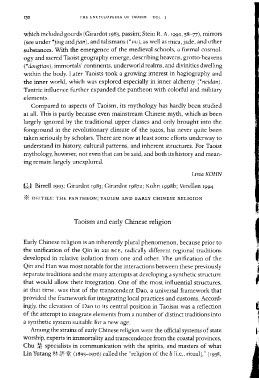Page 170 - The Encyclopedia of Taoism v1_A-L
P. 170
130 THE ENCYCLOPEDIA OF TAOISM VOL. I
which included gourds (Girardot 1983, passim; Stein R. A. 1990,58-77), mirrors
(see under *jing andjian), and talismans (*FU), as well as mica,jade, and other
substances. With the emergence of the medieval schools, a formal cosmol-
ogy and sacred Taoist geography emerge, describing heavens, grotto-heavens
(*dongtian), immortals' continents, underworld realms, and divinities dwelling
within the body. Later Taoists took a growing interest in hagiography and
the inner world, which was explored especially in inner alchemy (*neidan).
Tantric influence further expanded the pantheon with colorful and military
elements.
Compared to aspects of Taoism, its mythology has hardly been studied
at all. This is partly because even mainstream Chinese myth, which as been
largely ignored by the traditional upper classes and only brought into the
foreground in the revolutionary climate of the 1920S, has never quite been
taken seriously by scholars. There are now at least some efforts underway to
understand its history, cultural patterns, and inherent structures. For Taoist
mythology, however, not even that can be said, and both its history and mean-
ing remain largely unexplored.
LiviaKOHN
m Birrell 1993; Girardot 1983; Girardot 1987a; Kohn 1998b; Verellen 1994
* DEITIES: THE PANTHEON; TAOISM AND EARLY CHINESE RELIGION
,
Taoism and early Chinese religion
Early Chinese religion is an inherently plural phenomenon, because prior to ,
the unification of the Qin in 221 BCE, radically different regional traditions
developed in relative isolation from one and other. The unification of the
i
Qin and Han was most notable for the interactions between these previously ,
separate traditions and the many attempts at developing a synthetic structure
that would allow their integration. One of the most influential structures,
of the attempt to integrate elements from a number of distinct traditions into ,
at that time, was that of the transcendent Dao, a universal framework that
provided the framework for integrating local practices and customs. Accord-
ingly, the elevation of Dao to its central position in Taoism was a reflection
a synthetic system suitable for a new age. ,
Among the strains of early Chinese religion were the official systems of state l'
worship, experts in immortality and transcendence from the coastal provinces,
Chu ~ specialists in communication with the spirits, and masters of what
J
Lin Yutang 1+ Mf1l:t (1895-1976) called the "religion of the li [i.e., ritual]," (1938,

